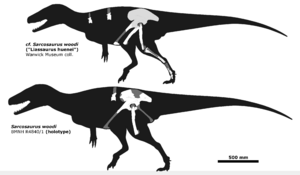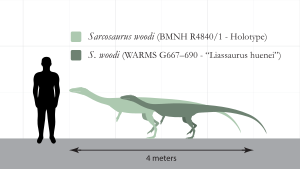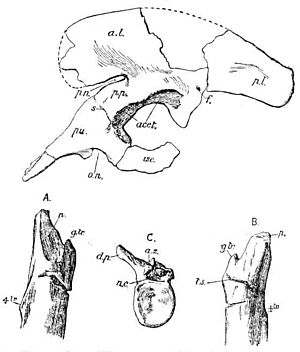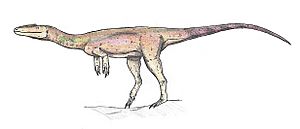Sarcosaurus facts for kids
Quick facts for kids Sarcosaurus |
|
|---|---|
 |
|
| Skeletons of the known specimens of Sarcosaurus woodi (restored as a ceratosaur) | |
| Scientific classification |
|
| Kingdom: | Animalia |
| Phylum: | Chordata |
| Clade: | Dinosauria |
| Clade: | Saurischia |
| Clade: | Theropoda |
| Clade: | Neotheropoda |
| Genus: | †Sarcosaurus Andrews, 1921 |
| Type species | |
| †Sarcosaurus woodi Andrews, 1921
|
|
| Synonyms | |
|
|
Sarcosaurus means "flesh lizard." It was a type of dinosaur called a neotheropod. These dinosaurs walked on two legs and were meat-eaters. Sarcosaurus lived in what is now England. It roamed the Earth during the Early Jurassic period, about 199 to 194 million years ago.
This dinosaur was one of the earliest known Jurassic theropods. It was also one of only a few theropod types from that time. Sarcosaurus was roughly 3.5 meters (about 11.5 feet) long.
Contents
What Did Sarcosaurus Look Like?
Sarcosaurus was a bipedal predator. This means it walked on two legs and hunted other animals for food. It was likely fast and could catch small prey.
Scientists have found different parts of Sarcosaurus skeletons. One main fossil (called the holotype) includes parts of its back, hips, and upper leg bone. This fossil belonged to an animal about 3.5 meters (11.5 feet) long. It probably weighed around 50 to 60 kilograms (110-132 pounds).
Another fossil, which was a complete lower leg bone (tibia), came from a larger Sarcosaurus. This dinosaur might have been up to 5 meters (16.4 feet) long. It could have weighed around 140 kilograms (308 pounds).
How Was Sarcosaurus Discovered?
The first Sarcosaurus fossils were found in England. They were discovered in an area called the Lower Lias. The main type of Sarcosaurus is called Sarcosaurus woodi.
A scientist named Charles William Andrews first described Sarcosaurus woodi in 1921. This happened shortly after S.L. Wood found a partial skeleton. The name Sarcosaurus comes from a Greek word meaning "flesh." The second part of its name, woodi, honors S.L. Wood.
The first fossil found included parts of its hip, a backbone, and the top of a leg bone. Over time, other fossils were found. Another species, Sarcosaurus andrewsi, was named in 1932. However, scientists later debated if these two species were truly different. In 2020, a study suggested that all the known Sarcosaurus fossils likely belonged to the same species, Sarcosaurus woodi.
Where Does Sarcosaurus Fit in the Dinosaur Family Tree?
When Sarcosaurus was first discovered, scientists thought it was related to a group called Megalosauridae. Later, some thought it might be part of the Coelophysidae family.
More recent studies have placed Sarcosaurus in different spots on the dinosaur family tree. Some research suggests it was a very early member of the Ceratosauria group. Other studies have linked it closely to Dilophosaurus.
In 2020, a study showed that Sarcosaurus was a close relative of a group called Averostra. This means it was an important dinosaur for understanding how early meat-eating dinosaurs evolved.
| Theropoda |
|
||||||||||||||||||||||||||||||||||||||||||||||||||||||||||||
What Was Sarcosaurus's Home Like?
The area where Sarcosaurus fossils were found was once a shallow sea. This sea was affected by changes in sea level. The climate was warm and mostly humid.
The rocks where the fossils were found show layers of mud and limestone. These layers often contain many fossils. This area was located at about 35 degrees North latitude during the Early Jurassic. It was an offshore area that sometimes experienced storms. Nearby land areas likely provided the plant and animal remains that ended up in the sea.
See also
 In Spanish: Sarcosaurus woodi para niños
In Spanish: Sarcosaurus woodi para niños
- Timeline of coelophysoid research




